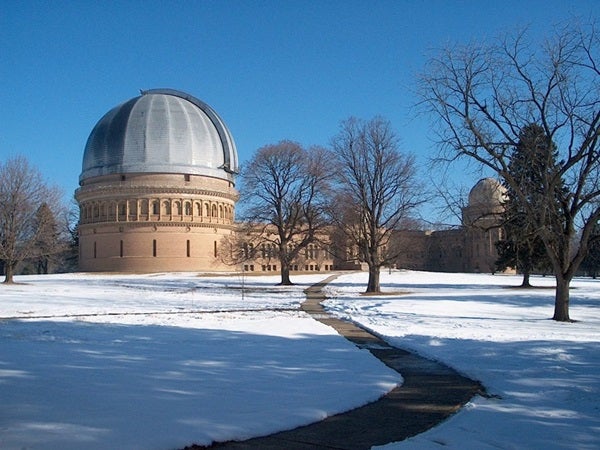The historic Yerkes Observatory, which houses the world’s largest refracting telescope, will live again thanks to a new agreement announced Tuesday. According to the deal, ownership of the famed observatory will transfer from the University of Chicago to the Yerkes Future Foundation — a preservation organization that aims to restore, refurbish, and reopen the storied building.
Though Yerkes Observatory was once a center of astronomical activity — Einstein famously named it one of the two places in the U.S. that he was interested in visiting — advances in telescope technology over the years reduced its scientific relevance. And in recent decades, the observatory’s future has become increasingly uncertain.
In 2004, the University of Chicago considered selling the observatory to an out-of-state developer. “I feared that Yerkes would become far less than what it was or could be and might eventually close,” says astronomer Kyle Cudworth of the University of Chicago, who was director of the Yerkes Observatory at the time.
The university ultimately decided not to sell the observatory, which is located about 90 miles (145 kilometers) northwest of Chicago in Williams Bay, Wisconsin. But from that point on, the university and community struggled over the fate of the facility, which carries with it significant history but diminishing financial prospects.
“The history’s incredible, and a bit overwhelming,” says Dianna Colman, chair of the Yerkes Future Foundation. “Drop a name, they’ve all been there.” The history of the Yerkes Observatory includes entrepreneurial astronomer George Ellery Hale, Nobel laureate Subrahmanyan Chandrasekhar, Albert Einstein, and “Mother of Hubble” Nancy Roman, not to mention generations of astronomers, NASA scientists and astronauts.
The Yerkes Observatory was Hale’s brainchild. In the late 1800s, the University of Southern California sought to build the world’s largest telescope, but ran out of funds. So Hale set out to bring the project to his home institution, the University of Chicago. He was able to convince the slick Chicago businessman Charles T. Yerkes to provide funding.
Henry Ives Cobb designed the buildings at Yerkes Observatory, adorning them with mythological themes, signs of the Zodiac, phases of the Moon and caricatures of the university’s first president, William Rainey Harper.
The observatory has amassed a collection of more than 100,000 observations, showing changes in astronomical objects over decades. Professor Rick Rees of Westfield State University calls himself one of the youngest astronomers, at 54, to work with photographic plates. He says Yerkes’ collection includes treasures such as Yerkes’ earliest plate capturing anything other than the Sun — specifically, the globular cluster M5.
Rees recalls seeing famous names on the cards of Yerkes library books they had checked out. “Holding [Edward Emerson] Barnard’s plates on which he discovered the star named for him is thrilling,” he recalls.
After more than a decade of uncertainty, the University of Chicago closed the observatory in October 2018, saying in a press release that the facility and its instrumentation “no longer contribute directly to the research mission of the University of Chicago.” The announcement went on highlight the university’s need to redirect resources to major investments in the Magellan and Giant Magellan telescopes in Chile.
The university’s efforts to find a new owner for the observatory were stymied, however, by the resurfacing of Yerkes’ gift letter, which stipulated that the University of Chicago continue to use the observatory for astronomical investigation. Otherwise, the building would revert to Yerkes’ heirs.
In order to save the observatory, a group of approximately 45 concerned individuals formed the Yerkes Future Foundation. Since then, the organization has been working with the university and Yerkes’ heirs to come to an agreement. “[The University of Chicago] needed clarity. We needed a plan,” Colman says. “They had to be confident we would preserve the observatory.” In addition to working out many other details, the foundation has employed the help of experts to determine the proper steps that need to be taken to preserve the observatory’s scientific instruments.
But Cudworth is hopeful about the observatory’s fate. “Now we have a local group whose priorities fit well with what Yerkes has been doing,” he says. For example, he cites Yerkes’ educational and public outreach projects, such as opportunities for local high school students to use Yerkes data to carry out longitudinal studies tracking the changing brightness of stars.
“With the announcement this week of the Yerkes Future Foundation agreement,” he adds, “I am hoping it won’t be too many more months before students can be back in Yerkes doing such research.”
Editor’s note: This story has been corrected from an earlier version. Yerkes’ collection includes the earliest photographic plate capturing anything other than the Sun that the observatory itself collected.











